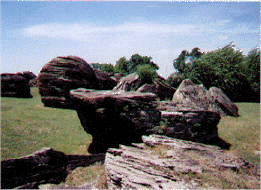Prehistory to 1799
- Geologic History
- Early Peoples and Indian
Civilizations
- European Explorers

Geologic History
Prehistory means the time period before man recorded events by writing. To
find out about this time we rely on information provided to us by scientists
called geologists, who study the earth, or
archeologists, who study the artifacts ancient
peoples left behind. Geologists use a
geologic timetable to describe how and when land was formed. They
have determined the earth to be at least
4 ½ billion years old! A
geologic map shows the layers of land that have developed in Kansas
through its history.
| To simplify their studies, geologists have
divided the study of time into 3 units: eras, periods and epochs. Different
rocks and minerals appeared during these times because of
glaciers, erosion, volcanoes, earthquakes and other natural
events. Large amounts of
sedimentary rocks are found throughout our state,
including sandstone and limestone.
As a result of these natural factors, various
landforms with very different physical appearances occur
in Kansas.
It is believed
life began on earth around 4 billion years ago.
About 300 million years ago, Kansas was located
close to the equator. Around this time, a vast inland
sea
covered Kansas.
Fossil remains of sharks, fish, reptiles, other animals and plants that lived in Kansas during this time can
often be found in rock formations in many parts of the state. As time
passed, the North American
continent drifted to the north away from the equator to its
present location. |

Sandstone formations at Rock City near Minneapolis |
Temperatures varied greatly at different times during the Earth's history,
Through the millions of years there have been several Ice Ages during which
glaciers covered much of the North American continent. Geologists believe at
least two of these glaciers reached the northeastern part of Kansas. These
glaciers carried rocks and boulders from South Dakota, Minnesota and Iowa and
deposited them in the
Glaciated section of northeastern Kansas. The last Ice
Age occurred around 18,000 B.C. Once the Ice Age ended, the climate
became more suitable for other forms of
life.

Additional Resources

Study Guide Questions
- What types of rocks are commonly found throughout
Kansas?
- Wh
at was Kansas
like 300 million years ago
- Why is Kansas so different today than it was 300
million years ago?
- How did rocks from the northern part of the country
end up in Kansas?
- Why are rocks and minerals useful to geologists?
- What are some rocks or minerals found in Kansas that
can be used to make various products we use today?
Back to Top
|